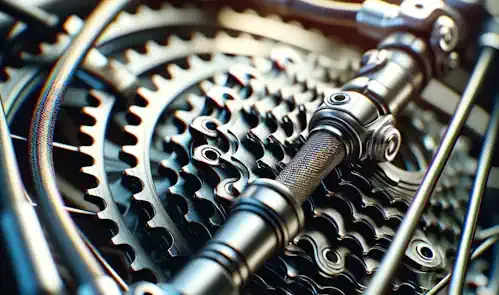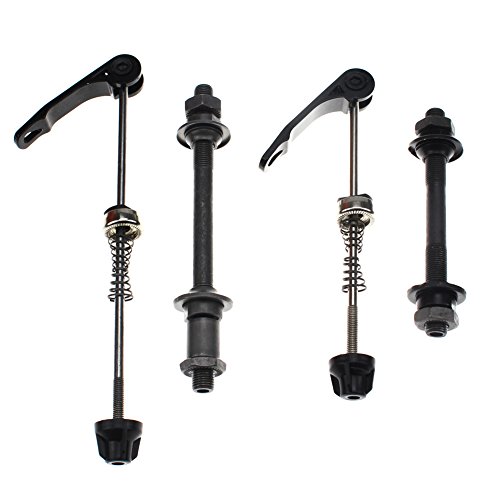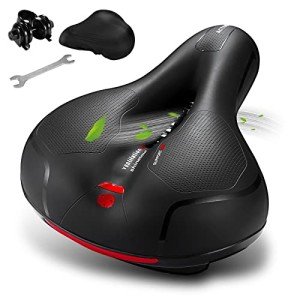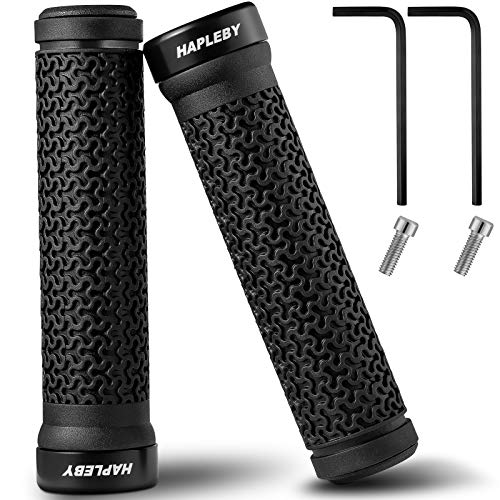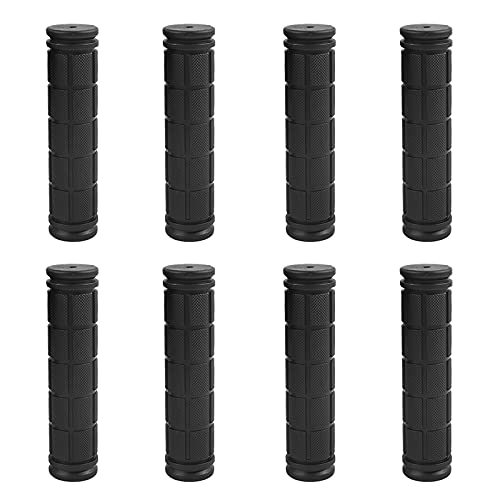Introduction
Bicycles are more than just a means of transportation; they're a symbol of freedom, fitness, and sustainability. Central to the performance and safety of these two-wheeled wonders are their intricate parts. Each component plays a crucial role in ensuring a smooth and secure ride, whether navigating city streets or conquering rugged trails.
The significance of bicycle parts cannot be overstated. From the robust frame to the smallest bolt, every element contributes to the overall functionality and efficiency of the bike. Understanding these parts, their functions, and how to maintain them is essential for every cyclist, whether novice or seasoned rider.
In this article, we delve into the world of bicycle parts, exploring their significance and the role they play in ensuring a smooth and safe ride. We'll discuss essential maintenance practices to keep your bike in top condition, considerations for replacement as parts wear out, and avenues for sourcing quality components. By the end, you'll have a comprehensive understanding of bicycle anatomy and the knowledge needed to maintain and upgrade your ride effectively.
Understanding Bicycle Parts
Bicycles are intricate machines composed of several key components, each serving a specific function vital to the overall performance and functionality of the bike. Here's an overview of some of the most crucial bicycle parts and their significance:
Frame:
The frame is the backbone of the bicycle, providing structural support and determining its overall geometry and handling characteristics.
It absorbs and distributes the forces generated during riding, ensuring stability and durability.
Different frame materials, such as aluminum, steel, carbon fiber, or titanium, offer varying levels of stiffness, weight, and comfort.
Wheels:
Wheels consist of rims, spokes, and hubs, with tires mounted on them.
They provide traction, support the weight of the rider and the bike, and facilitate forward motion.
Wheel size, rim width, spoke tension, and tire pressure significantly impact ride quality, handling, and efficiency.
Drivetrain:
The drivetrain encompasses the chain, crankset, chainrings, cassette, derailleurs, and shifters.
It transfers power from the rider's legs to the wheels, propelling the bike forward.
Gear ratios and shifting mechanisms allow cyclists to adjust their pedaling resistance and maintain an optimal cadence across various terrain.
Brakes:
Brakes are crucial for safety, allowing riders to slow down or stop the bike as needed.
Common types include rim brakes (caliper or cantilever), disc brakes (mechanical or hydraulic), and coaster brakes.
Properly functioning brakes are essential for controlling speed and negotiating obstacles, especially during descents or emergencies.
Handlebars:
Handlebars provide the rider with steering control and support for the hands and upper body.
Different styles, such as drop bars, flat bars, or riser bars, offer varying hand positions and riding postures suited to different preferences and disciplines.
Handlebar width, shape, and material influence comfort, aerodynamics, and handling responsiveness.
Pedals:
Pedals are where the rider's feet make contact with the bike and provide the driving force.
They come in various types, including platform pedals, clipless pedals, and toe clips/straps, each offering different levels of efficiency and foot retention.
Pedal choice affects power transfer efficiency, comfort, and the rider's ability to maintain control, especially during high-intensity efforts.
These components do not operate in isolation; rather, they form an interconnected system where each part's performance influences the others. Understanding how these parts work together is essential for optimizing the bicycle's performance, comfort, and safety. Regular maintenance, proper adjustment, and occasional upgrades ensure that each component functions harmoniously, allowing cyclists to enjoy a smooth and efficient ride, whether commuting, touring, or competing.
Maintenance Practices
Regular maintenance is crucial for preserving the lifespan and performance of bicycle parts, ensuring that your ride remains safe, efficient, and enjoyable over time. By investing time and effort into basic upkeep, cyclists can prevent premature wear and tear, minimize the risk of mechanical failures, and prolong the longevity of their bikes. Here's why maintenance matters and some essential practices to keep your bicycle in top condition:
Importance of Regular Maintenance:
Regular maintenance helps prevent minor issues from escalating into major problems, saving time and money in the long run.
It prolongs the lifespan of components, reducing the need for frequent replacements and upgrades.
Well-maintained bicycles perform better, providing smoother operation, improved handling, and enhanced safety for the rider.
Basic Maintenance Tasks:
Cleaning: Regularly clean your bike to remove dirt, grime, and debris that can accumulate on the frame, drivetrain, and other components. Use a mild detergent, water, and a soft brush or sponge to scrub away dirt, and rinse thoroughly afterward.
Lubrication: Apply lubricant to the chain, derailleurs, cables, and other moving parts to reduce friction, prevent corrosion, and maintain smooth operation. Wipe off excess lubricant to prevent attracting dirt and grime.
Inspection: Regularly inspect your bike for signs of wear, damage, or misalignment. Check for loose bolts, worn brake pads, chain stretch, tire wear, and any unusual noises or vibrations while riding.
Identifying and Addressing Common Issues:
Worn Components: Replace worn-out parts such as brake pads, chain, cassette, and tires promptly to maintain optimal performance and safety.
Loose Bolts: Check all bolts and fasteners regularly to ensure they are tightened to the manufacturer's specifications. Pay particular attention to critical areas such as stem, handlebars, seatpost, and crankset.
Misalignment: Check for misalignment of wheels, brake calipers, derailleurs, and handlebars. Use appropriate tools to make necessary adjustments and ensure proper alignment for optimal performance and safety.
By incorporating these maintenance practices into your routine, you can prolong the lifespan of your bicycle and enjoy a smoother, safer, and more enjoyable riding experience. Regular cleaning, lubrication, and inspection help prevent premature wear and tear, identify potential issues early, and keep your bike operating at its best. Remember to consult your bike's manual or seek professional assistance for more advanced maintenance tasks or repairs beyond your expertise.
Replacement Considerations
Knowing when to replace bicycle parts is essential for maintaining optimal performance, safety, and longevity. Various signs indicate the need for replacement, ranging from visible wear and tear to decreased performance and safety concerns. Here's a guide to help you determine when it's time to replace different components on your bike:
Signs of Wear, Damage, or Decreased Performance:
Visible Wear: Look for signs of wear such as fraying cables, worn brake pads, chain stretch, or cracked tires. These indicate that the part has reached the end of its usable lifespan and needs replacement.
Damage: Inspect components for any signs of damage, including cracks, dents, bends, or corrosion. Damaged parts compromise the structural integrity and safety of the bike and should be replaced promptly.
Decreased Performance: Pay attention to changes in performance, such as difficulty shifting gears, reduced braking power, or increased noise and vibration while riding. These could indicate worn or damaged components that require replacement.
Guidance on Replacement Timing:
Usage and Mileage: Consider the frequency and intensity of your riding when determining replacement intervals. Components subjected to heavy use or high-mileage rides may wear out faster and require more frequent replacement.
Visual Inspection: Regularly inspect your bike for signs of wear, damage, or performance issues. Develop a habit of checking key components after each ride or at regular intervals to identify potential problems early and address them before they escalate.
Importance of Compatible Replacement Parts:
Compatibility: Ensure that replacement parts are compatible with your bike's make, model, and specifications. Using incompatible parts can lead to fitment issues, poor performance, and safety hazards.
Material and Size: Consider factors such as material composition and size when choosing replacement parts. Opt for high-quality materials that offer durability and performance suitable for your riding style and conditions.
Compatibility with Other Components: Ensure that replacement parts are compatible with other components on your bike, such as drivetrain compatibility with chainrings, cassettes, and derailleurs. Using mismatched parts can result in compatibility issues and suboptimal performance.
By paying attention to signs of wear, damage, and decreased performance, you can proactively replace worn-out components before they compromise your riding experience or safety. Prioritize compatibility and quality when selecting replacement parts to ensure optimal fit, performance, and longevity for your bike. If you're unsure about replacement intervals or compatibility, consult with a professional mechanic or refer to your bike's manual for guidance.
Availability of Bicycle Parts
Ensuring access to bicycle parts is essential for maintaining and upgrading your bike. Fortunately, there are various avenues through which cyclists can obtain the parts they need, ranging from local brick-and-mortar shops to online retailers and manufacturer's websites. Here's an overview of the different options available and some tips for sourcing parts efficiently:
Local Bike Shops:
Local bike shops (LBS) are a go-to option for many cyclists due to their convenience and personalized service.
LBS typically carry a wide range of parts and accessories, offer expert advice and recommendations, and provide professional installation and repair services.
Building a relationship with your local bike shop can be beneficial, as they can offer personalized recommendations based on your specific needs and preferences.
Online Retailers:
Online retailers provide a vast selection of bicycle parts and accessories, often at competitive prices.
Popular online marketplaces and specialty cycling websites offer convenience, extensive product catalogs, and the ability to compare prices and read reviews from other cyclists.
However, be mindful of shipping times, return policies, and potential compatibility issues when purchasing parts online.
Manufacturer's Websites:
Many bicycle manufacturers offer direct-to-consumer sales through their official websites.
Ordering parts directly from the manufacturer ensures compatibility and authenticity, particularly for proprietary components or specialized accessories.
Manufacturer's websites may also provide resources such as user manuals, technical specifications, and compatibility guides to help you make informed purchasing decisions.
Factors Influencing Part Availability:
Popularity: Parts for popular bike brands or models are typically more readily available due to higher demand.
Brand: Established brands with a strong presence in the cycling industry often have extensive distribution networks and readily available parts.
Production Cycles: Availability of certain parts may be influenced by production cycles, seasonal demand, or supply chain disruptions.
Tips for Sourcing Parts Efficiently:
Research Alternatives: If a specific part is unavailable or back-ordered, consider alternative brands or compatible components that offer similar features and functionality.
Consider Aftermarket Options: Aftermarket parts and accessories can offer comparable performance and quality at a lower cost than original equipment manufacturer (OEM) parts.
Plan Ahead: Anticipate your maintenance and upgrade needs in advance to allow sufficient time for sourcing parts and scheduling installations or repairs.
Consult Experts: Seek advice from experienced cyclists, mechanics, or online forums for recommendations on sourcing hard-to-find parts or compatible alternatives.
By exploring different avenues for obtaining bicycle parts and considering factors such as availability, compatibility, and cost, cyclists can effectively source the components they need to maintain, repair, or upgrade their bikes. Whether you prefer the convenience of online shopping, the expertise of a local bike shop, or the assurance of ordering directly from the manufacturer, there are plenty of options available to meet your cycling needs.
Maintenance and Replacement Best Practices
Maintaining and replacing bicycle parts is essential for keeping your bike in optimal condition and ensuring a smooth, safe ride. By following best practices for maintenance and replacement, you can prolong the lifespan of your bike and minimize the need for costly repairs. Here's a detailed guide on performing common maintenance tasks and safely replacing worn or damaged parts:
Cleaning:
Start by removing any accessories or components that may obstruct access to the areas needing cleaning.
Use a gentle detergent or bike-specific cleaner and a soft brush or sponge to scrub away dirt, grime, and grease from the frame, drivetrain, wheels, and other components.
Rinse thoroughly with clean water to remove soap residue, and dry with a soft towel or cloth.
Pay special attention to areas prone to buildup, such as the chain, cassette, and derailleur pulleys.
Finish by applying a protective coating of bike polish or wax to the frame and components to repel dirt and moisture.
Lubrication:
Clean the chain and drivetrain thoroughly using a degreaser and a brush to remove old lubricant, dirt, and debris.
Apply a small amount of bicycle-specific lubricant to each link of the chain, allowing it to penetrate and coat the moving parts.
Wipe off excess lubricant with a clean rag to prevent attracting dirt and grime.
Apply lubricant to other moving parts such as derailleurs, shifters, brake pivots, and cables as needed, and wipe off excess.
Adjustment:
Regularly check and adjust key components such as brakes, derailleurs, and headset for proper alignment and operation.
Use appropriate tools, such as hex wrenches, screwdrivers, and cable cutters, to make necessary adjustments to brake pads, cable tension, limit screws, and bearing preload.
Refer to your bike's manual or online tutorials for specific adjustment procedures and recommended torque settings.
Replacement:
Identify worn or damaged parts such as brake pads, chain, cassette, tires, and cables that need replacement.
Gather the necessary tools, including wrenches, screwdrivers, tire levers, and a chain tool if replacing the chain.
Follow manufacturer instructions or consult online resources for step-by-step guides on safely removing and installing the replacement parts.
Take your time and double-check your work to ensure proper fitment, alignment, and functionality of the new parts.
Preventive Measures:
Keep your bike clean and well-lubricated to prevent premature wear and corrosion.
Check your bike regularly for signs of wear, damage, or misalignment, and address any issues promptly.
Follow recommended maintenance intervals for key components such as chain lubrication, brake adjustment, and tire pressure.
Avoid riding in harsh conditions or terrain that may accelerate wear and tear on your bike.
By following these maintenance and replacement best practices, you can keep your bicycle in top condition and enjoy a smooth, safe riding experience for years to come. Regular cleaning, lubrication, adjustment, and timely replacement of worn or damaged parts are essential for preserving the lifespan of your bike and minimizing the need for costly repairs.
Maintaining and Replacing Bicycle Parts
Understanding, maintaining, and replacing bicycle parts are essential aspects of ensuring a safe and enjoyable riding experience. By familiarizing yourself with the various components of your bike, performing regular maintenance tasks, and addressing worn or damaged parts promptly, you can prolong the lifespan of your bike and enhance its performance and reliability.
Cyclists are encouraged to stay proactive in caring for their bikes, whether it's cleaning and lubricating the drivetrain, adjusting brakes and derailleurs, or replacing worn-out components. Regular inspection and preventive maintenance can help prevent mechanical issues and safety hazards, ensuring that your bike remains in top condition for every ride.
While many maintenance tasks can be performed by cyclists themselves, it's important to recognize when professional assistance may be needed, especially for complex repairs or adjustments. Local bike shops and experienced mechanics can provide expert guidance, diagnosis, and repair services to keep your bike running smoothly.
Lastly, cyclists have access to a wealth of resources for further information on bicycle maintenance and part replacement. Whether it's instructional videos, online tutorials, bike manuals, or community forums, there are numerous avenues for learning and troubleshooting. Take advantage of these resources to expand your knowledge and skills in caring for your bike.
By prioritizing understanding, maintenance, and replacement of bicycle parts, cyclists can ensure a safe, reliable, and enjoyable riding experience for miles to come. Whether you're commuting, touring, or hitting the trails, a well-maintained bike is your ticket to adventure and freedom on two wheels.
